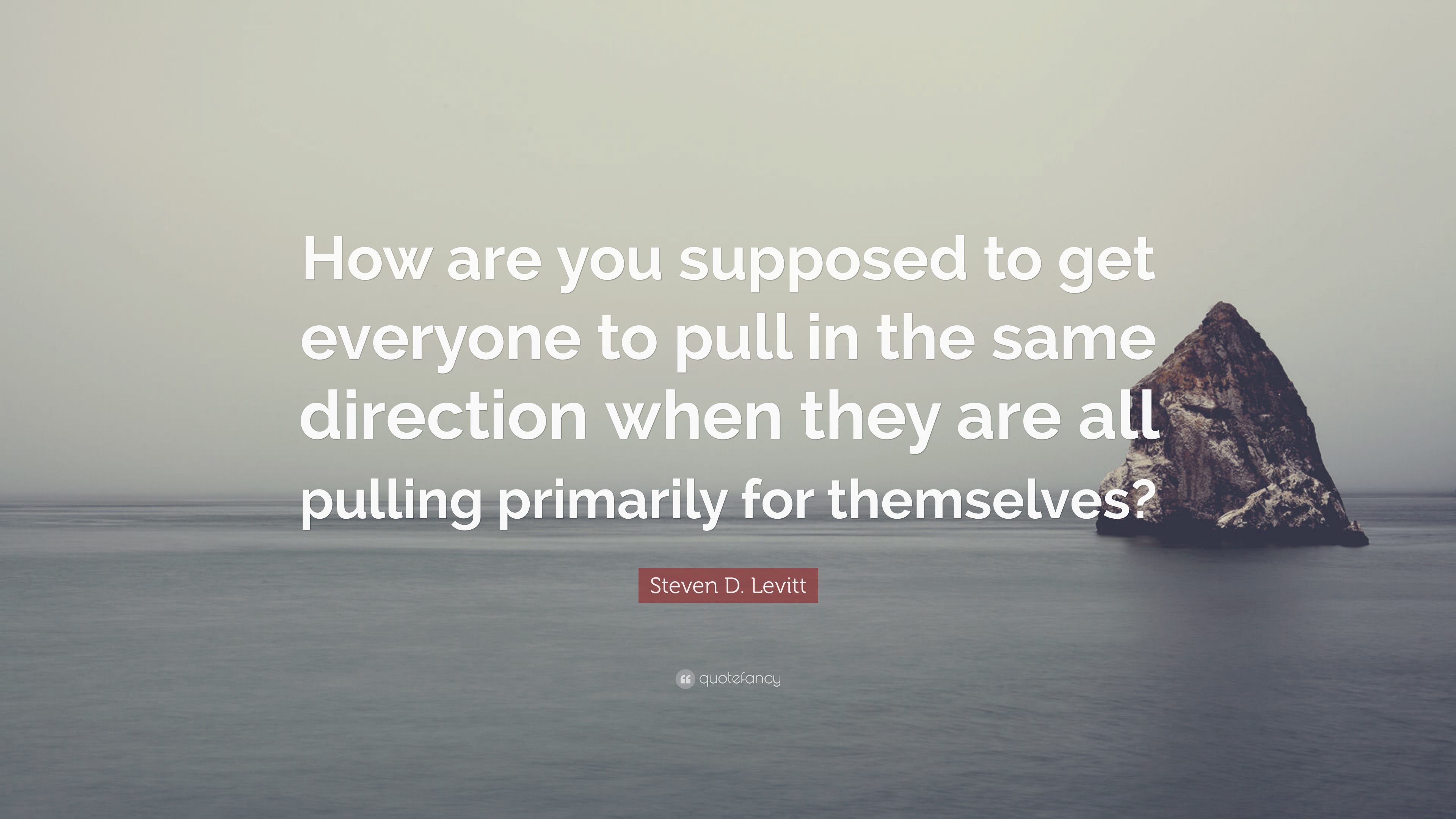Theyre all pulling in the same direction nyt – As “They’re All Pulling in the Same Direction” takes center stage, this opening passage beckons readers into a world crafted with knowledge, ensuring a reading experience that is both absorbing and distinctly original. This comprehensive guide delves into the intricacies of collaborative success, exploring the strategies and principles that empower teams to achieve remarkable results.
From aligning goals and objectives to fostering open communication and building trust, this guide provides a roadmap for creating a cohesive and productive work environment. Through real-world examples and practical tips, readers will gain valuable insights into the art of collaboration, enabling them to unlock the full potential of their teams.
Alignment of Goals and Objectives
Alignment of goals and objectives plays a crucial role in uniting individuals and organizations towards a common purpose. When everyone is pulling in the same direction, it fosters collaboration, efficiency, and ultimately leads to greater success.
In organizations, aligning goals ensures that all employees understand the overall mission and vision. It provides a shared understanding of priorities, allowing teams to work together effectively and avoid duplication of efforts. A clear alignment of goals creates a sense of purpose and motivation, encouraging individuals to contribute their best efforts.
Examples of Alignment
- In a healthcare organization, aligning the goals of doctors, nurses, and support staff ensures that patient care is the top priority. Everyone works together to provide the best possible treatment and support.
- In a manufacturing company, aligning the goals of production, sales, and marketing teams ensures that products are produced efficiently, meet customer needs, and are marketed effectively.
Collaborative Communication and Decision-Making: Theyre All Pulling In The Same Direction Nyt

Effective communication is crucial for aligning efforts and achieving shared goals. It allows team members to understand each other’s perspectives, share information, and make informed decisions. Open and transparent communication fosters trust and respect, creating a positive work environment where individuals feel comfortable contributing their ideas and perspectives.To foster open dialogue and consensus building, consider the following strategies:
Encourage Active Listening, Theyre all pulling in the same direction nyt
Active listening involves paying full attention to what others are saying, both verbally and nonverbally. By demonstrating empathy and understanding, individuals create a safe space for others to share their thoughts and ideas.
Facilitate Regular Communication
Regular team meetings, brainstorming sessions, and check-ins provide opportunities for team members to connect, share updates, and discuss progress. Establishing clear communication channels and protocols ensures that everyone has access to the information they need.
Use a Variety of Communication Methods
Utilize a combination of communication channels, including face-to-face meetings, video conferencing, instant messaging, and email. This allows individuals to choose the most appropriate method for their needs and preferences.
Promote Inclusivity
Encourage participation from all team members, regardless of their role or seniority. Create a culture where everyone’s voice is valued and respected, fostering a sense of belonging and collaboration.
Establish Clear Decision-Making Processes
Define clear roles and responsibilities for decision-making, ensuring that everyone understands their authority and the process for reaching consensus. This helps to streamline decision-making and avoid confusion or delays.
In a world where digital devices dominate our lives, the ability to reset our gadgets when they malfunction is crucial. If your iPhone is locked and you can’t access it, don’t fret. You can easily factory reset it by following these simple steps: how to factory reset iphone when locked.
On a different note, the recent headlines from the New York Times alters the narrative in a way nyt that challenges the established norms and perspectives.
Shared Values and Culture

Shared values form the foundation of a cohesive team. They provide a common ground for individuals to work together effectively, creating a sense of belonging and purpose. Organizations that cultivate a culture of collaboration reap numerous benefits, including improved productivity, innovation, and employee engagement.
Examples of Organizations with Collaborative Cultures
- Google:Known for its open and innovative culture, Google encourages employees to collaborate and share ideas across teams.
- Pixar:The animation studio fosters a collaborative environment where artists, animators, and technicians work closely together to create award-winning films.
- Zappos:The online retailer emphasizes a customer-centric culture, with employees empowered to make decisions and collaborate to resolve customer issues.
Trust and Accountability

Trust is the cornerstone of any successful team. When team members trust each other, they are more likely to feel responsible for their own actions and the team’s success. They are also more likely to be accountable to each other, meaning they will hold each other to a high standard of performance.
There are many ways to build trust within a team. One important way is to create a supportive work environment. This means providing team members with the resources and support they need to be successful. It also means creating a culture of respect and open communication.
Tips for Building Trust
- Be honest and transparent with team members.
- Keep your promises.
- Be supportive and helpful.
- Celebrate successes together.
- Learn from mistakes.
Leadership and Facilitation
Effective leadership is crucial for guiding and motivating teams towards shared goals. Leaders set the vision, communicate expectations, and create an environment that fosters collaboration.
The New York Times recently altered the narrative in a way that has sent shockwaves through the media landscape. By focusing on the human stories behind the headlines, the Times has challenged the traditional narrative and forced us to confront the complexities of the world we live in.
Leadership Styles for Collaboration
Successful leadership styles for promoting collaboration include:
Democratic leadership
If you’re ever in a situation where your iPhone is locked and you need to factory reset it, don’t worry. There’s a simple process you can follow to get your device back to its original settings. Here’s how to factory reset an iPhone when locked.
Involving team members in decision-making and encouraging open communication.
Participative leadership
Empowering team members to contribute ideas and take ownership of projects.
Transformational leadership
Inspiring and motivating team members to go beyond their limits and embrace change.
Servant leadership
Focusing on supporting and empowering team members, rather than solely on personal authority.
Conflict Resolution and Team Dynamics
Conflict is an inherent part of any team dynamic, and while it can be challenging, it can also be a catalyst for growth and innovation. By addressing conflicts constructively and maintaining team harmony, teams can harness the power of diverse perspectives and experiences to drive success.
Here are some strategies for resolving conflicts constructively and maintaining team harmony:
Open Communication
Encourage open and honest communication among team members. Create a safe space where individuals feel comfortable expressing their thoughts and feelings without fear of judgment or reprisal.
Active Listening
Practice active listening by paying full attention to what others are saying, both verbally and nonverbally. Show that you are engaged and understanding by nodding, making eye contact, and asking clarifying questions.
Empathy
Try to understand the perspectives of others, even if you don’t agree with them. Put yourself in their shoes and try to see the situation from their point of view.
Compromise
Be willing to compromise and find solutions that meet the needs of all parties involved. This may involve finding common ground or negotiating a mutually acceptable outcome.
Seek External Support
If conflicts cannot be resolved internally, consider seeking external support from a mediator or facilitator. An outside perspective can help to facilitate a constructive dialogue and find a resolution that is acceptable to all.
Performance Measurement and Evaluation
Measuring team collaboration effectiveness is crucial for continuous improvement. Key performance indicators (KPIs) provide quantifiable metrics to assess team performance. These KPIs can include:
| KPI | Description |
|---|---|
| Communication Frequency | Number of team interactions per week |
| Task Completion Rate | Percentage of tasks completed on time |
| Collaboration Tool Usage | Frequency of using collaboration tools (e.g., shared calendars, project management software) |
| Team Member Satisfaction | Feedback on team dynamics, collaboration, and overall satisfaction |
In addition to KPIs, other methods for evaluating team effectiveness include:
- Peer Feedback:Team members provide anonymous feedback on each other’s performance and collaboration.
- 360-Degree Feedback:Feedback is collected from team members, managers, and stakeholders.
- Team Assessments:Structured assessments that measure team dynamics, communication, and problem-solving abilities.
- Project Reviews:Evaluation of team performance on specific projects, focusing on collaboration and outcomes.
Continuous Improvement and Innovation
Continuous improvement is a key aspect of effective team collaboration. It involves constantly evaluating and refining processes, tools, and communication strategies to enhance teamwork and productivity.
Organizations that embrace continuous improvement often see significant benefits, including increased efficiency, improved decision-making, and enhanced team morale.
Best Practices for Continuous Improvement
- Regularly gather feedback:Seek input from team members on areas for improvement, both formally and informally.
- Use data to drive decisions:Track key metrics and analyze data to identify areas where processes can be streamlined or improved.
- Implement a suggestion system:Encourage team members to submit ideas for improvements, and provide a mechanism for evaluating and implementing them.
- Foster a culture of experimentation:Encourage team members to try new approaches and take calculated risks in pursuit of improvement.
- Celebrate successes:Recognize and reward team members for their contributions to continuous improvement efforts.
Examples of Innovative Approaches to Collaboration
- Google Docs:Google Docs allows multiple users to collaborate on documents in real-time, facilitating seamless teamwork and document sharing.
- Slack:Slack is a messaging platform that enables team members to communicate and collaborate efficiently, regardless of their location.
- Trello:Trello is a project management tool that uses visual boards to track tasks, collaborate on projects, and manage team workloads.
- Zoom:Zoom is a video conferencing platform that enables teams to connect virtually, regardless of their location, fostering collaboration and building relationships.
- Monday.com:Monday.com is a work operating system that combines project management, communication, and collaboration tools into a single platform, streamlining teamwork and enhancing productivity.
Final Wrap-Up
In conclusion, “They’re All Pulling in the Same Direction” serves as an invaluable resource for anyone seeking to enhance collaboration within their organization. By embracing the principles Artikeld in this guide, leaders and teams can cultivate a culture of unity, innovation, and exceptional performance.
FAQs
What are the key elements of effective collaboration?
Effective collaboration hinges on shared goals, open communication, trust, accountability, and a supportive leadership style.
How can organizations foster a culture of collaboration?
Organizations can cultivate a collaborative culture by promoting shared values, encouraging open dialogue, and providing opportunities for team members to connect and build relationships.
What are the benefits of collaboration in the workplace?
Collaboration fosters innovation, improves problem-solving, enhances employee engagement, and leads to increased productivity and organizational success.
